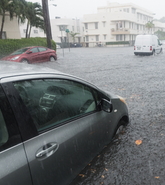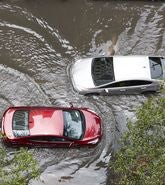For almost all of us, COVID-19 represented our first experience of a rapidly growing exponential harm. Back in late January 2020, the scariest harbinger of the advancing pandemic was that the numbers of infected and dying were doubling, unremittingly, every three or four days. Projecting out a month or two, without any intervention, fatalities were set to rise into the hundreds of thousands.
Everyone has become familiar with the regularly published “R” reproduction number, which reports the average number of new cases attributed to each infected individual. An R figure above 1 corresponds to COVID-19 infections accelerating. This R value, a parameter previously only known to epidemiologists, is the root cause of the exponential growth.
Many elements of the COVID-19 pandemic have parallels with the threat from climate change. Both have extraordinary systemic impacts. Both bring chronic and acute impacts on human health. For both, the cost of containment will be very high. A 2018 study calculated the expected annual global losses from pandemics at US$500 billion - or 0.6 percent of global income. For climate change the Intergovernmental Panel on Climate Change (IPCC) has estimated costs at between 0.2 and 2 percent of global income.
Climate Change Risks
Unpacking the risks from climate change includes many individual perils, components, and situations, some of which are profoundly non-linear. If our eyes have been opened by the experience of the pandemic, maybe we can better anticipate the exponential harms caused by climate change? Instead of biological reproduction powering geometric growth – that R value – we have “positive feedbacks” – processes in which the products of an action cause more of that action to occur.
For example, there is more warming and more feedback at higher latitudes. The melting of the Greenland ice sheet, which covers 660,000 square miles, leads to a reduction in elevation and albedo (reflective power), raising the surface temperature, and increasing the rate of melting. The rate of ice loss has increased almost tenfold between the mid-1990s through to the period 2012-17, implying a doubling time of about six years.
Meanwhile, since the late 1970s, the minimum annual (September) extent of Arctic sea ice has been shrinking at an average of 13.4 percent each decade, halving in area every 45 years. As sea ice melts, the albedo of the surface reduces sharply as less sunlight is reflected into space, and so the surface water grows warmer and further melts the ice pack.
But positive feedbacks are not just found at high latitudes. Reductions in foliage because of dead trees in California bring higher temperatures, leading to more trees dying. Meanwhile, from a combination of increased exposure and rising hazard, the costs of wildfires in California have been doubling approximately every six years since the late 1980s.
Over the past 150 years, after adjusting for inflation, the U.S. economy has grown at a 1.83 percent annual compound growth rate, doubling every 40 years. Since 1950, the increment in atmospheric greenhouse gases has doubled about every 25 years. We can hope, at least, that the exponential increase has now slowed, as economic growth gets delinked from greenhouse gas emissions, thanks in part to the expansion of renewable energy. After 2006, an exponential growth of solar photovoltaic (PV) capacity has doubled every three or four years; by 2019 there had been 27 percent annual growth over the previous four years. World wind power capacity has been doubling every three years since 2000.
Some actions have been more accidental. In the 1970s, 58,000 large dams stopped sea level rise and overall reduced the rise by 12 percent, but drowned forests have led to increases in emissions. Raised carbon dioxide levels lead to faster growth of vegetation, while warming has expanded forests at high latitudes, absorbing more carbon dioxide. Other actions drive in the wrong direction. Increased temperatures lead to more air conditioning installations that leads to more emissions in energy production, further raising temperatures. Perhaps all air conditioning should be required to be solar powered.
Getting Used to Rapid Exponential Increase
The underlying “rapid exponential increase” is why, in February 2020, politicians in Europe and the Americas were initially unable to appreciate the gravity of the situation when they first saw statistics of the new coronavirus, as they were not familiar with such accelerating deterioration. All of us have had to get smarter at grasping the interaction between more person-to-person contact, rising COVID-19 case rates, ICU bed capacity, and corresponding death rates. Actions taken to reduce human contact, such as closing shops and bars, and wherever possible requiring people to work from home have had demonstrable impacts in reducing the R value. But at the same time these actions have caused economic damage, especially to certain sectors of small and medium-sized enterprises.
Instances of exponential increase are also the reason that our leaders may fail to appreciate the accelerating consequences of climate change. Even while the doubling times for components of climate change are around a thousand times slower than for the second wave of COVID-19, there is no conceivable lockdown – or vaccine for that matter – that will prevent the ice sheets from melting faster or chill California heatwaves.
But with our collective experience of COVID-19 giving an understanding and appreciation of the impact of exponential growth, maybe it is time to elevate the status of what is a climate emergency. We will need regular communication: clear metrics on current and future climate perils, what are the main drivers of physical damage and human displacement where we are heading, and the benefits in risk reduction of alternative adaptation initiatives. With many governments announcing ambitious carbon-neutral policies, capitalizing on our nascent risk awareness and mitigation capabilities built from the pandemic could galvanize global efforts to tackle another global threat that is also growing exponentially: climate change.







